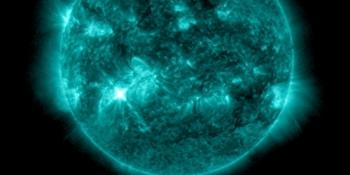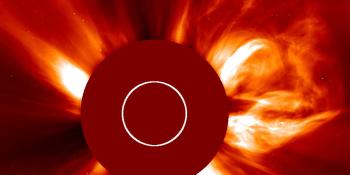Visualizzazione archivio di sabato, 5 febbraio AM
Rapporto attività solare
Ogni brillamento solare menzionato nel rapporto ha un fattore di scala, applicato dal Centro di Predizione Meteorologica Spaziale (SWPC). A causa del fattore di scala del SWPC, i brillamenti solari sono segnalati come ridotti del 42%, rispetto ai dati di qualità scientifica. Il fattore di scala è stato rimosso dai nostri dati archiviati sui brillamenti solari, per riflettere le unità fisiche reali.
Rapporto dell'Attività Geofisica Solare 2011 Feb 05 2200 UTCPreparati dal SWPC della NOAA© ed elaborati da SpaceWeatherLive.com
Rapporto Congiunto USAF/NOAA dell'Attività Solare e Geofisica
SDF Numero 036 Emesso alle 2200Z il Feb 05 2011IA. Analisi delle Regioni Solari Attive e Attività dalle 2100Z-04 alle 2100Z-05 Solar activity has been very low for the past 24 hours.
Region 1152 (S18W14) and Region 1153 (N15W31) have begun to decay
with a loss in areal coverage, magnetic complexity, and a reduced
sunspot number. Region 1150 (S20, L=187) decayed to spotless plage
early in the period.
IB. Previsione dell'Attività Solare
Solar activity is expected to be very
low with a slight chance for C-class activity for the next three
days (06-08 February).
IIA. Sommario dell'Attività Geofisica dalle 2100Z-04 alle 2100Z-05
The geomagnetic field has been at quiet to active levels with an
isolated period at G1 ,minor storm levels, from 4/2100Z-4/2400Z.
This increase in activity was associated with a reverse shock behind
a slow moving CME observed on 30 January. Observations from the ACE
spacecraft indicated the effects of the shock subsided around
4/0421Z, as a recurrent coronal hole high speed stream, in which the
CME was embedded, regained dominance. Throughout the period, the
total Interplanetary Magnetic Field (IMF) decayed from 17 nT at
04/2106Z to 3nT at 05/2008Z. Solar wind speeds peaked at around 675
km/s at 05/0536Z, but speeds began to decrease as the day
progressed.
IIB. Previsione dell'Attività Geofisica
The geomagnetic field is
expected to be quiet to unsettled for the next two days (06-07
February) as the effects of the latest recurrent coronal hole high
speed stream wane. A return to quiet levels is expected on day three
(08 February).
III. Probabilità dell'Evento dalle Feb del 06 alle Feb del 08
| Classe M | 01% | 01% | 01% |
| Classe X | 01% | 01% | 01% |
| Protone | 01% | 01% | 01% |
| PCAF | Green | ||
IV. Flusso di 10.7 cm di Penticton
Osservato 05 Feb 081 Previsto 06 Feb-08 Feb 080/080/080 Media di 90 Giorni 05 Feb 084
V. Indici Geomagnetici A
Osservato Afr/Ap 04 Feb 012/021 Stimato Afr/Ap 05 Feb 015/018 Previsto Afr/Ap 06 Feb-08 Feb 008/010-008/008-005/005
VI. Probabilità dell'Attività Geomagnetica dal 06 Feb al 08 Feb
| A. Latitudini Medie | |||
|---|---|---|---|
| Attivo | 20% | 20% | 05% |
| Tempesta minore | 05% | 05% | 01% |
| Tempesta maggiore-grave | 01% | 01% | 01% |
| B. Latitudini Alte | |||
|---|---|---|---|
| Attivo | 25% | 25% | 10% |
| Tempesta minore | 10% | 10% | 01% |
| Tempesta maggiore-grave | 01% | 01% | 01% |
Tutti gli orari in UTC
<< Vai alla pagina della panoramica giornaliera
Ultime notizie
Ultimi messaggi dal forum
Coronal mass ejection impact and G4 geomagnetic storm 10 & 11 October 2024 934AR 3938 21AR 13933 9AR 13932 89AR13936 6
Altri argomentiSupporta SpaceWeatherLive.com!
Molte persone vengono su SpaceWeatherLive per seguire l'attività del Sole o sapere se ci sia la possibilità di vedere l'aurora, ma a maggior traffico corrispondono costi maggiori. Considerate una donazione se vi piace SpaceWeatherLive così che possiamo mantenere online il sito web!

Notizie sul meteo spaziale
| Ultimo brillamento X | 2024/12/08 | X2.2 |
| Ultimo brillamento M | 2024/12/26 | M7.3 |
| Ultima tempesta geomagnetica | 2024/12/17 | Kp5+ (G1) |
| Giorni senza macchie | |
|---|---|
| Ultimo giorno senza macchie | 2022/06/08 |
| Media mensile Numero di Macchie Solari | |
|---|---|
| novembre 2024 | 152.5 -13.9 |
| dicembre 2024 | 119.3 -33.2 |
| Last 30 days | 122 -35.7 |


